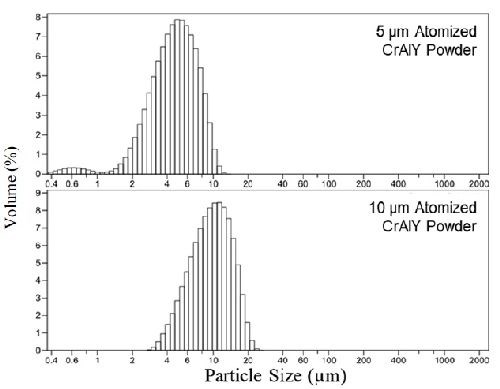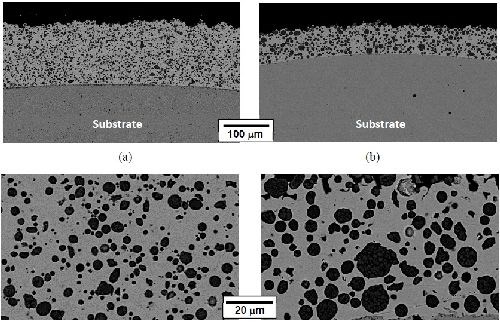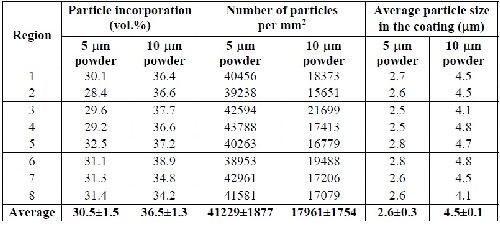Electrocodeposition of MCrAlY Coatings for Advanced Gas Turbine Applications - 7th Quarterly Research Report
This NASF-AESF Foundation research project report covers the seventh quarter of project work (July-September 2019) on the AESF Foundation Research project at the Tennessee Technological University. The objective of the work is to study and optimize the MCrAlY electro-codeposition process to improve the coating oxidation/corrosion performance. In this quarter, the effect of the particle size of gas-atomized CrAlY powders on electro-codeposited Ni-CrAlY composite coatings was studied.
Editor’s Note: This NASF-AESF Foundation research project report covers the seventh quarter of project work (July-September 2019) on an AESF Foundation Research project at the Tennessee Technological University, Cookeville, Tennessee. A printable PDF version of this report is available by clicking HERE.
Summary: in the third quarter of Year 2, the effect of the particle size of gas-atomized CrAlY powders on electro-codeposited Ni-CrAlY composite coatings was studied. The specimens were plated in a closed rotating barrel, and commercial CrAlY powders with two different particle sizes (i.e., ~5 μm and ~10 μm) were used. The powder concentration in the plating solution was varied at two levels, 20 g/L and 60 g/L, respectively. When the particle concentration in the solution was increased from 20 to 60 g/L, the particle incorporation (vol%) was increased, especially for the 5-μm powder. For both powder concentrations, higher particle incorporation was observed for the 10-μm powder (~36 vol%), as compared to the 5-μm powder (28-31 vol%). Although the coating deposited using the 10-μm powder showed higher particle incorporation, the number of particles per unit area was much lower, only approximately 44% of what was incorporated in the coating deposited with the 5-μm powder. In addition, for both powders, the average size of the embedded particles was much smaller (about half) than that of the starting powders. These results suggest that it is more difficult to keep larger particles in suspension in the rotating barrel. The larger particles also require higher metal deposition rate in order to be embedded in the coating.
Technical report
I. Introduction
To improve high-temperature oxidation and corrosion resistance of critical superalloy components in gas turbine engines, metallic coatings such as diffusion aluminides or MCrAlY overlays (where M = Ni, Co or Ni+Co) have been employed, which form a protective oxide scale during service.1 The state-of-the-art techniques for depositing MCrAlY coatings include electron beam-physical vapor deposition (EB-PVD) and thermal spray processes.1 Despite the flexibility they permit, these techniques remain line-of-sight which can be a real drawback for depositing coatings on complex-shaped components. Further, high costs are involved with of the EB-PVD process.2 Several alternative methods of making MCrAlY coatings have been reported in the literature, among which electro-codeposition appears to be a more promising coating process.
Electrolytic codeposition (also called “composite electroplating”) is a process in which fine powders dispersed in an electroplating solution are codeposited with the metal onto the cathode (specimen) to form a multiphase composite coating.3,4 The process for fabrication of MCrAlY coatings involves two steps. In the first step, pre-alloyed particles containing elements such as chromium, aluminum and yttrium are codeposited with the metal matrix of nickel, cobalt or (Ni,Co) to form a (Ni,Co)-CrAlY composite coating. In the second step, a diffusion heat treatment is applied to convert the composite coating to the desired MCrAlY coating microstructure with multiple phases of β-NiAl, γ-Ni, etc.5
Compared to conventional electroplating, electro-codeposition is a more complicated process because of the particle involvement in metal deposition. It is generally believed that five consecutive steps are engaged:3,4 (i) formation of charged particles due to ions and surfactants adsorbed on particle surface, (ii) physical transport of particles through a convection layer, (iii) diffusion through a hydrodynamic boundary layer, (iv) migration through an electrical double layer and (v) adsorption at the cathode where the particles are entrapped within the metal deposit. The quality of the electro-codeposited coatings depends upon many interrelated parameters, including the type of electrolyte, current density, pH, concentration of particles in the plating solution (particle loading), particle characteristics (composition, surface charge, shape, size), hydrodynamics inside the electroplating cell, cathode (specimen) position, and post-deposition heat treatment if necessary.3-6
There are several factors that can significantly affect the oxidation and corrosion performance of the electrodeposited MCrAlY coatings, including: (i) the volume percentage of the CrAlY powder in the as-deposited composite coating, (ii) the CrAlY particle size/distribution and (iii) the sulfur level introduced into the coating from the electroplating solution. This three-year project aims to optimize the electro-codeposition process for improved oxidation/corrosion performance of the MCrAlY coatings. The three main tasks are as follows:
- Task 1 (Year 1): Effects of current density and particle loading on CrAlY particle incorporation.
- Task 2 (Year 2): Effect of CrAlY particle size on CrAlY particle incorporation.
- Task 3 (Year 3): Effect of electroplating solution on the coating sulfur level.
In the previous reporting period (Sixth Quarterly Report: http://short.pfonline.com/NASF19Oct2), the effect of particle size of ball-milled CrAlY powders on the particle incorporation in the coating was investigated using a closed barrel. In the current reporting period, a similar study was conducted for gas-atomized CrAlY powders.
II. Experimental procedure
Cylindrical SS304 specimens were ground to #600 grit using SiC grinding papers, followed by grit blasting with #220 Al2O3 grit. The specimens were then ultrasonically cleaned in hot water and acetone. Gas-atomized CrAlY powders (58% Cr, 30% Al and 2% Y, wt%) with two different particle sizes purchased from Sandvik were used in the electro-codeposition experiments.
The specimens were plated in a closed rotating barrel system, as described in US Patent Application 623497787 and in the 2019-Q2 Report (http://short.pfonline.com/NASF18Oct1). There are several benefits associated with the closed barrel configuration. First, the particle size that can be incorporated in the composite coating is not limited by the pore size of the nylon membrane, and codeposition of smaller particles (even nanoparticles) is thus possible with this configuration. Second, the amount of plating solution required is significantly reduced, which can be particularly useful for exploration of new solutions. The closed barrel configuration is hence more suitable for the investigation of the particle size effect.
Watts nickel-cobalt plating solution was utilized in electro-codeposition. The particle concentration in the solution was varied at two levels, 20 g/L and 60 g/L, respectively. A relatively low current density (5 mA/cm2) was applied in the current electro-codeposition experiments. The specimens were plated at 50°C with a solution pH level of 3.0-4.0. The barrel rotation speed was maintained at 4 RPM.
Particle size analysis of the gas-atomized CrAlY powders was carried out using a Malvern Mastersizer 2000 Laser diffractor. The NiCo-CrAlY composite coatings were characterized by scanning electron microscopy (SEM) equipped with energy dispersive spectroscopy. Prior to metallographic sample preparation, the specimens were copper-plated to improve edge retention. To determine the volume fraction of the incorporated CrAlY particles, multiple backscattered electron images were taken from different locations along the coating cross-section, which were then processed using the ImageJ software. The brightness and contrast of the image were adjusted by setting a proper threshold such that the particles were separated from the background. The area fraction of the CrAlY particles was determined, which was assumed equivalent to its volume fraction.
III. Results and discussion
The particle distributions of the two commercial gas-atomized CrAlY powders are presented in Fig. 1 and summarized in Table 1. The D50 values for the smaller and larger particles were 4.7 μm and 9.8 μm, respectively. The two powders are referred to as “5-μm” and “10-Vm” powders hereafter.
Table 1 - Summary of particle size data of the gas-atomized CrAlY powders.


Figure 1 – Particle size distributions of 5-μm and 10-μm gas-atomized CrAlY powders.
Figure 2 shows the SEM cross-sectional images at two different magnifications of the as-deposited NiCo-CrAlY coatings. The coating displayed in Figs. 2(a & c) was plated using the 5-μm CrAlY powder and the coating with the 10-μm powder is shown in Figs. 2(b & d). The difference in particle size can be clearly seen, particularly at the higher magnification, Figs. 2(c &d). It is worth noting that while all other electro-codeposition parameters remained the same, the plating time was different for the two coating samples, resulting in different coating thicknesses.

Figure 2 – SEM cross-sectional images of as-deposited NiCo-CrAlY coatings plated using powders with difference particle sizes: (a) and (c) 5-µm particles; (b) and (d) 10-µm particles.
Table 2 summarizes the CrAlY particle incorporation in the coatings deposited with 5- and 10-μ[JL1] m powders with different particle concentrations in the plating solution. When the CrAlY particle loading was increased from 20 to 60 g/L, the particle incorporation in the NiCo-CrAlY coating was increased, especially for the 5-μm powder. Regardless of the particle loading, consistently higher particle incorporation (based on vol%) was obtained for the 10- μm powder, ~36%, as compared to the 5- μm powder (28-31%).
Table 2 - Summary of CrAlY particle incorporation in NiCo-CrAlY coatings.

Table 3 provides a more detailed comparison between the volume fraction of particle incorporation and the number of particles in the coatings plated with 60 g/L particle loading. The measurements were taken in eight different areas on each specimen. Although the coating deposited using the 10-μm powder showed higher volume fractions of CrAlY particles, the number of particles per unit area was much lower, approximately 44% of what was incorporated in the coating deposited with the 5-μm powder. In addition, for both powders, the average size of the embedded particles was much smaller (about half) than that of the starting powders.
Table 3 - Comparison of the volume fraction and the number of CrAlY particles in the coating for 60 g/L particle loading.

Particle size and density can change the magnitude of forces acting on the particles both while being suspended in the solution and when in contact with the component surface. When a sedimentation or barrel configuration is used, the velocity of the particle is dictated by a balance of gravitational forces and hydrodynamic drag forces. For larger and heavier particles, the agitation required to suspend the particles becomes quite high. In addition, larger particles are more susceptible to hydrodynamic forces further diminishing their ability to be embedded. Both particle size and density have been shown to increase the sediment velocity of the particles.8,9 The increase of particle velocity can increase the particle transport to the component surface, which in turn increases the particle concentration at the surface. Nevertheless, not only is gravity acting on the particles but electrophoretic, hydrodynamic and electrochemical forces are also exerting on the particles. Additionally, adhesion forces are being applied to the particles as the metal matrix forms around the particle. The sum of these forces dictates if a particle will become permanently incorporated in the coating.
References
1. G.W. Goward, Surf. Coat. Technol., 108-109, 73-79 (1998).
2. A. Feuerstein, et al., J. Therm. Spray Technol., 17 (2), 199-213 (2008).
3. C.T.J. Low, R.G.A. Wills and F.C. Walsh, Surf. Coat. Technol., 201 (1-2), 371-383 (2006).
4. F.C. Walsh and C. Ponce de Leon, Trans. Inst. Metal Fin., 92 (2), 83-98 (2014).
5. Y. Zhang, JOM, 67 (11), 2599-2607 (2015).
6. B.L. Bates, J.C. Witman and Y. Zhang, Mater. Manuf. Process, 31 (9), 1232-1237 (2016).
7. J.C. Witman, Y. Zhang, and B.L. Bates, “Apparatus Used for Producing Coatings,” Patent Application #62349778 (2016).
8. J. Foster, B.P. Cameron and J.A. Carew, Trans. Inst. Metal Finish., 63 (1), 115-119 (1985).
9. L. Stappers and J. Fransaer, J. Electrochem. Soc., 153 (7), C472-C482 (2006).
Past project reports
1. Quarter 1 (January-March 2018): Summary: NASF Report in Products Finishing; NASF Surface Technology White Papers, 82 (12), 13 (September 2018); Full paper: http://short.pfonline.com/NASF18Sep1.
2. Quarter 2 (April-June 2018): Summary: NASF Report in Products Finishing; NASF Surface Technology White Papers, 83 (1), 13 (October 2018); Full paper: http://short.pfonline.com/NASF18Oct1.
3. Quarter 3 (July-September 2018): Summary: NASF Report in Products Finishing; NASF Surface Technology White Papers, 83 (3), 15 (December 2018); Full paper: http://short.pfonline.com/NASF18Dec1..
4. Quarter 4 (October-December 2018): Summary: NASF Report in Products Finishing; NASF Surface Technology White Papers, 83 (7), 11 (April 2019); Full paper: http://short.pfonline.com/NASF19Apr1.
5. Quarter 5 (January-March): Summary: NASF Report in Products Finishing; NASF Surface Technology White Papers, 83 (10), 11 (July 2019); Full paper: http://short.pfonline.com/NASF19Jul1.
6. Quarter 6 (April-June): Summary: NASF Report in Products Finishing; NASF Surface Technology White Papers, 84 (1), 17 (October 2019); Full paper: http://short.pfonline.com/NASF19Oct2.
About the authors

Dr. Ying Zhang is Professor of Mechanical Engineering at Tennessee Technological University, in Cookeville, Tennessee. She holds a B.S. in Physical Metallurgy from Yanshan University (China)(1990), an M.S. in Materials Science and Engineering from Shanghai University (China)(1993) and a Ph.D. in Materials Science and Engineering from the University of Tennessee (Knoxville)(1998). Her research interests are related to high-temperature protective coatings for gas turbine engine applications; materials synthesis via chemical vapor deposition, pack cementation and electrodeposition, and high-temperature oxidation and corrosion. She is the author of numerous papers in materials science and has mentored several Graduate and Post-Graduate scholars.

Dr. Jason C. Whitman is a Materials Lab Engineer at National Aerospace Solutions, LLC at Arnold AFB, Tennessee. His primary work with AESF Foundation Research Project R-119, was as a Graduate Research Assistant at Tennessee Technological University in Cookeville, Tennessee, from which he earned a B.S. degree in Mechanical Engineering (2012), and a Ph.D. in Mechanical Engineering in (2018).
*Corresponding author:
Dr. Ying Zhang, Professor
Department of Mechanical Engineering
Tennessee Technological University
Cookeville, TN 38505-0001
Tel: (931) 372-3265
Fax: (931) 372-6340
Email: yzhang@tntech.edu
Related Content
Troubleshooting Alkaline Zinc
One of the most common problems that can arise when plating with alkaline zinc is an imbalance of brightener in the solution. In this helpful Ask the Expert article, Chad Murphy of Columbia Chemical discusses how different zinc metal concentrations and brightener concentrations can impact efficiency.
Read MorePossibilities From Electroplating 3D Printed Plastic Parts
Adding layers of nickel or copper to 3D printed polymer can impart desired properties such as electrical conductivity, EMI shielding, abrasion resistance and improved strength — approaching and even exceeding 3D printed metal, according to RePliForm.
Read MoreHow to Choose Between Sulfate and Chloride-Based Trivalent Chromium
There are several factors to consider when choosing between sulfate and chloride-based baths for trivalent chromium plating. Mark Schario of Columbia Chemical discusses the differences and what platers should keep in mind when evaluating options.
Read MoreHow to Maximize Nickel Plating Performance
The advantages of boric acid-free nickel plating include allowing manufacturers who utilize nickel plating to keep up the ever-changing regulatory policies and support sustainability efforts.
Read MoreRead Next
A ‘Clean’ Agenda Offers Unique Presentations in Chicago
The 2024 Parts Cleaning Conference, co-located with the International Manufacturing Technology Show, includes presentations by several speakers who are new to the conference and topics that have not been covered in past editions of this event.
Read MoreEducation Bringing Cleaning to Machining
Debuting new speakers and cleaning technology content during this half-day workshop co-located with IMTS 2024.
Read MoreDelivering Increased Benefits to Greenhouse Films
Baystar's Borstar technology is helping customers deliver better, more reliable production methods to greenhouse agriculture.
Read More





















